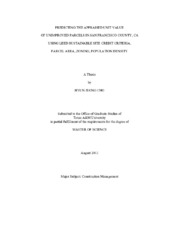| dc.description.abstract | Nowadays many people recognize the need for sustainable development more than ever because of improper urban sprawl, rapid exhaustion of natural resources, and serious environmental problems.
Emission of carbon dioxide from transportation sources causes severe air contamination, and this will increase due to the continued use of private vehicles. Thus, local governments are trying to keep public transit on a satisfactory level due to rising commuting time for cities. The U.S. Census shows that the majority of people would prefer to use their private automobile rather than utilize existing mass transit systems. Therefore, it is up to local governments to consider setting up more efficient alternative mass transit systems to deal with the increasing pollution caused by automobiles.
Organizations adopt certain environmental standards for many different reasons, such as commitment to environmental issues affecting their industry. Other organizations could also benefit, both economically and environmentally, by utilizing such standards. The LEED (Leadership in Energy and Environmental Design) rating system is one of the more commonly-used environmental standards which presents guidelines for making decisions regarding land development while preserving the environment. However, only a few studies have attempted to evaluate this voluntary rating system which makes it difficult to justify the motivation of organizations that have adopted such voluntary standards. In this respect, this research primarily aims to explore the economic influence on the market value of undeveloped land through an analysis of public transportation in San Francisco, CA. Population density and area of each parcel are the factors considered to make the predictive model more powerful.
Findings in this study show that LEED PTA (Public Transportation Accessibility) criteria, and population density significantly affect the appraised land unit value in specific purposed zones. Particularly, the economic impact of public transportation accessibility tended to be positive. With these findings, the statistical model for predicting land value was created. The result of this research can assist developers to make better site selections to accelerate the growth of sustainable construction. | en |


